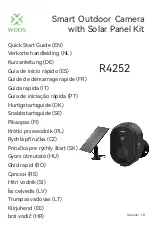
www.qimaging.com
©2014 QImaging. All rights reserved. QI_OPTIMOS_UM_Rev_A0
14
optiMOS USER MANUAL
functions described in the specifications chapter) on the back of the camera for TTL communication. A special
trigger cable is available as an accessory which allows the user to access the primary hardware signals including
“Trigger in,” “Expose out,” and “Trigger Ready.”
As discussed above, unlike CCD cameras the optiMOS uses a rolling shutter readout. This readout mode
has the advantages of low noise and extremely high frame rates but also provides some challenges when
attempting to synchronize with external equipment. For some experiments, it is important to keep the
benefits of rolling shutter while avoiding spatial artifacts and fluorescence channel overlap. In order to achieve
this, both the camera’s triggering modes and the expose out behavior needs to be synchronized with other
hardware devices. optiMOS supports three trigger modes and three expose out behaviors for a total of nine
synchronization configurations that can be tailored to various experimental requirements. The triggering
modes and expose out behaviors of the camera are described below.
Hardware Triggering Modes
Timed Mode
Default mode of the optiMOS and is a software triggering mode. This means, the software/application initiates
the start of a sequence of acquisitions. Once initiated, each frame capture in the sequence is controlled by the
internal timing generators of the camera. Camera settings, expose out behavior and sequence size is set in the
software application prior to acquiring the sequence. Timed mode is used when synchronization with other
devices is either not required or is controlled independently through the software.
Trigger-First Mode
Similar to Timed Mode but requires a hardware trigger from the I/O connector instead of a software/application
trigger. Hardware triggers enable higher precision of acquisition timing than software triggers. Rising edge of
an external trigger initiates the start of a sequence of acquisitions. Once initiated, each frame capture in the
sequence is controlled by the internal timing generators of the camera. Camera settings, expose out behavior
and sequence size is set in the software application prior to acquiring the sequence.
Edge Mode
Like Trigger-First Mode, Edge Mode requires a hardware trigger but this time for every frame. The rising edge
of the external trigger initiates capture of a single frame. Each frame requires an external trigger from the I/O
connector. Camera settings, expose out behavior and sequence size is set in the software application prior to
acquiring the sequence.
Содержание OptiMOS Series
Страница 1: ...U S E R M A N U A L www QIMAGING com ...












































